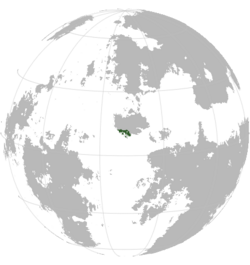Iarisuko
Revision as of 07:55, 9 December 2023 by Loglorn (talk | contribs) (Created page with "{{Infobox country |conventional_long_name = Republic of Iarisuko |native_name = ''Iạrisúkọ́'' |common_name = Iarisuko |image_flag = Iarisukoflag.png |alt_flag = Flag of Iarisuko |image_flag2 = <!--e.g. Second-flag of country.svg--> |alt_flag2 = <!--alt text for second flag--> |image_coat = <!--e.g. Coat of arms of country.svg--> |alt_coat = <!--alt text for coat of arms--> |symbol_type = <!--e...")
| Republic of Iarisuko Iạrisúkọ́ |
||||
|---|---|---|---|---|
|
||||
| Capital and | Iarisuko City | |||
| Official languages | Iarisuko Nyigoi Nkanjum |
|||
| Government | Some flavour of republic | |||
| Establishment | ||||
| - | De jure controlled by the Letsatian Empire | 25-180 CE | ||
| - | Founding of the first centralized city-states | 200s CE | ||
| - | Formation of the Yaañitsuko Dynasty | 708 CE | ||
| - | Height of the Yaañitsuko trade cycles | Early 1200s | ||
| - | Yaañitsuko trade cycles cease | 1330 CE | ||
| - | Conquest by the Aituxe State | 1661 CE | ||
| - | Dissolution of the Aituxe State | 1781 CE | ||
| - | Unification under the Magalese Republic | 1860 CE | ||
| - | De facto independence from Magali | 1922 CE | ||
| Area | ||||
| - | 138,602 km2 53,515 sq mi |
|||
| Population | ||||
| - | estimate | 19 265 678 | ||
| - | Density | 139/km2 360/sq mi |
||
'Iarisuko (Iarisuko: iạrisúkọ́ [IPA]), officially the Republic of Iarisuko, is a country located in Akulanen and neighbouring the Taanttu Sea to the south and west, Magali to the north and Amerhan to the east. While the land that is now Iarisuko has spent most of history being disputed between Magalese and Amerhani polities, it was the center of the Yaañitsuko Dinasty between 708 and 1330 CE. The Yaañitsuko had an expansive trade network, ranging as far as Dhwer and maybe even Lhavres
Etymology
The name comes from the Ghoni *yàŋu-ʒwúk-wâ, probably meaning "fortress" (lit. long-tall-G23). It is thought to refer to the local practice of building fortified inzynds, perhaps already due to Iarisuko's historical position as a border land.

